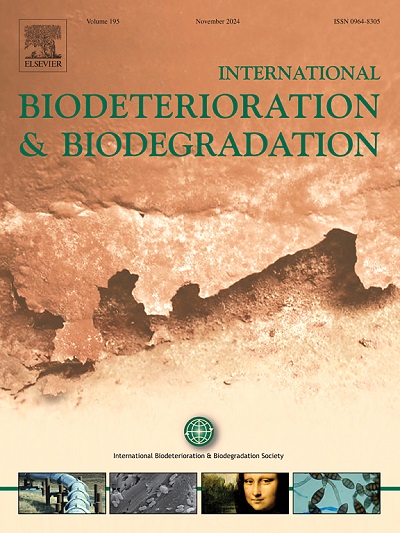Influence of polyethylene glycol and various carboxylic acids on the biological durability of beech wood (Fagus sylvatica) and Scots pine sapwood (Pinus sylvestris)
IF 4.1
2区 环境科学与生态学
Q2 BIOTECHNOLOGY & APPLIED MICROBIOLOGY
International Biodeterioration & Biodegradation
Pub Date : 2025-05-23
DOI:10.1016/j.ibiod.2025.106127
引用次数: 0
Abstract
The goal of this study was to investigate the impact of wood modification with polyethylene glycol (PEG) 400 and various carboxylic acids (citric acid (CA), malic acid (MA) and 1,2,3,4-butanetetracarboxylic acid (BTCA)) on the biological durability of beech wood (Fagus sylvatica) and Scots pine sapwood (Pinus sylvestris). For the brown, white and soft rot experiments, mass losses (ML) were calculated according to the respective standards. Weight percent gain, bulking and anti-swelling efficiency were determined to determine the quality of the modifications. Modifying agents, fixed inside the wood, demonstrated anti-swelling efficiency after leaching cycles (beech wood: 9–46 %). The decay resistance against brown and white rot fungi was considerably improved, with PEG/CA and PEG/BTCA being more effective than PEG/MA. Beech wood modified with PEG/CA achieved durability class (DC) 1–2, PEG/BTCA reached DC 1 and PEG/MA fell into DC 2–4. For Scots pine sapwood, PEG/CA and PEG/BTCA reached DC 1, while PEG/MA only achieved DC 4. The biological durability against soft rot fungi was less affected, and curing alone did not enhance the resistance to soft rot fungi. PEG/BTCA achieved DC 1, while PEG/MA and PEG/CA ranged between DC 1 and DC 3. The variants with different CA to PEG ratios as well as CA without PEG showed no major differences in terms of ML due to soft rot fungi. In conclusion, the modifications resulted in significantly lower mass losses.
聚乙二醇和各种羧酸对山毛榉木和苏格兰松材生物耐久性的影响
本研究的目的是研究聚乙二醇(PEG) 400和不同羧酸(柠檬酸(CA)、苹果酸(MA)和1,2,3,4-丁烷四羧酸(BTCA))改性木材对山毛榉木(Fagus sylvatica)和苏格兰松材(Pinus sylvestris)生物耐久性的影响。褐腐、白腐和软腐试验的质量损失(ML)按各自标准计算。通过测定增重率、膨胀率和抗膨胀率来确定改性的质量。改性剂,固定在木材内部,显示出浸出循环后的抗膨胀效率(山毛榉木:9 - 46%)。PEG/CA和PEG/BTCA对褐腐和白腐真菌的抗腐性显著提高,PEG/CA和PEG/BTCA的抗腐性优于PEG/MA。PEG/CA改性山毛榉木材的耐久性等级(DC)为1 - 2级,PEG/BTCA为DC 1级,PEG/MA为DC 2-4级。对于苏格兰松边材,PEG/CA和PEG/BTCA达到DC 1, PEG/MA仅达到DC 4。对软腐菌的生物耐久性影响较小,单独养护不能提高软腐菌的耐受性。PEG/BTCA达到DC 1, PEG/MA和PEG/CA介于DC 1和DC 3之间。不同CA / PEG比的变异体和没有PEG的变异体在软腐菌引起的ML方面没有显着差异。总之,改进后的质量损失显著降低。
本文章由计算机程序翻译,如有差异,请以英文原文为准。
求助全文
约1分钟内获得全文
求助全文
来源期刊
CiteScore
9.60
自引率
10.40%
发文量
107
审稿时长
21 days
期刊介绍:
International Biodeterioration and Biodegradation publishes original research papers and reviews on the biological causes of deterioration or degradation.

 求助内容:
求助内容: 应助结果提醒方式:
应助结果提醒方式:


